How to Remove Sticker Residue: Easy and Effective Methods for Any Surface
.jpg)
To remove a sticker residue, gently remove excess glue with a cloth or a hard card. After that, immediately apply a solvent like rubbing alcohol or vinegar. Let the surface soak in. Now, carefully remove the sticker residue. If stubborn residues persist, let the solvent sit for a few minutes before wiping. A commercial adhesive remover can also be used.
Stickers are an excellent way to convey primary information about a brand in the packaging and printing industry. A common issue that brands, factories, and retail teams face is sticker and label residue. This residue can become an unsightly mess that can be difficult to remove and cause damage to the product. A sticky patch on a display or product can make a new item look used. For this, you need methods that work fast, don't damage surfaces, and are safe for employees on the floor or in the warehouse.
To solve this issue, we have written this step-by-step blog guide that helps you remove sticker residue from any surface, including glass, car, skin, laptop, plastic, metal, and other things. After recommendations and suggestions from experts, we have also mentioned why some adhesives are harder to remove. Anyone can use these methods to cut rework, reduce returns, and keep product presentation sharp.
Let’s start.
Key Takeaways:
- Gently remove excess glue first.
- Use a solvent like rubbing alcohol or vinegar.
- Stubborn residue needs a longer soaking time.
- Age and heat make the adhesive more stubborn.
- Residue degrades products and looks messy.
- Household tools: oil, alcohol, vinegar, heat.
- Commercial removers are best for tough glue.
- Plastic needs gentle oils; avoid strong solvents.
- Glass responds well to alcohol or vinegar.
- Use a razor blade carefully on wet, plain glass.
- Metal tolerates stronger solvents than plastic.
- Freeze fabric or use alcohol for clothes.
- Cars require specific automotive-safe removers.
- Electronics, including laptops, need minimal high-purity alcohol.
- Always test products on an inconspicuous spot.
What Is Sticker Residue?
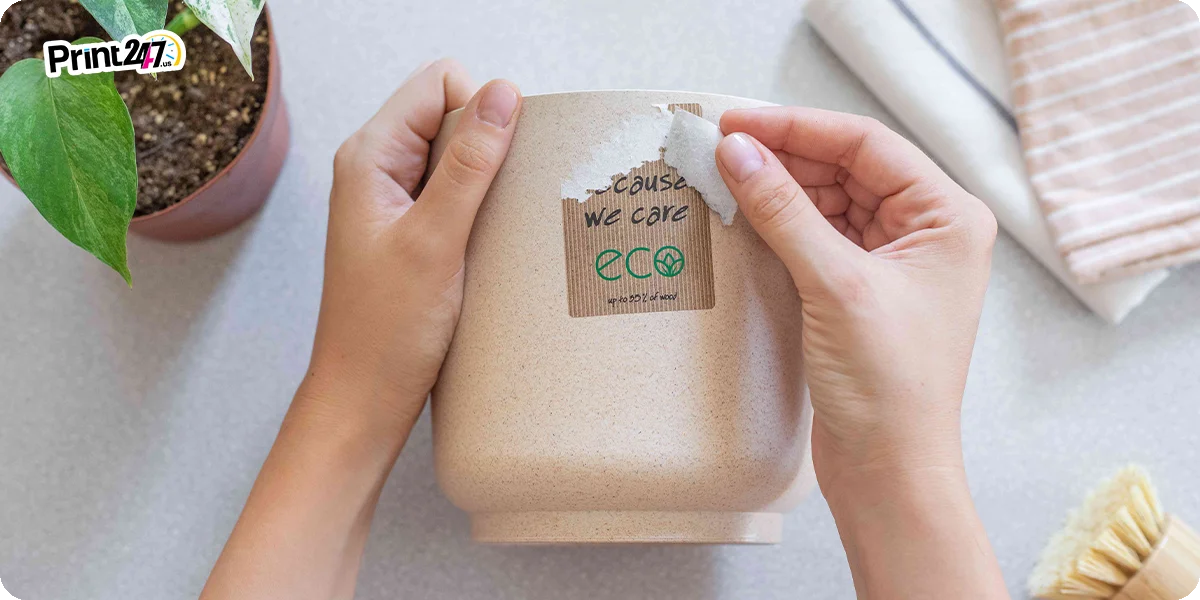
Sticker residue, often referred to as adhesive leftover, is a sticky, gummy material left behind on a surface after peeling off a custom sticker, label, price tag, or decal. It is the result of a strong adhesive that makes a bond with the surface when pressure is applied.
When you try to remove the sticker, that strong adhesive may not come off cleanly, and it may stick to the surface. As soon as it's exposed to open air, it quickly attracts dirt, dust, and other environmental contaminants, turning it from a clear, sticky spot into one that is dark, gritty, and stubborn.
If you leave it untreated, it can even make it harder to remove over time as the solvents in the adhesive evaporate and the remaining polymers cure.
Why Are Stickers Sticky?
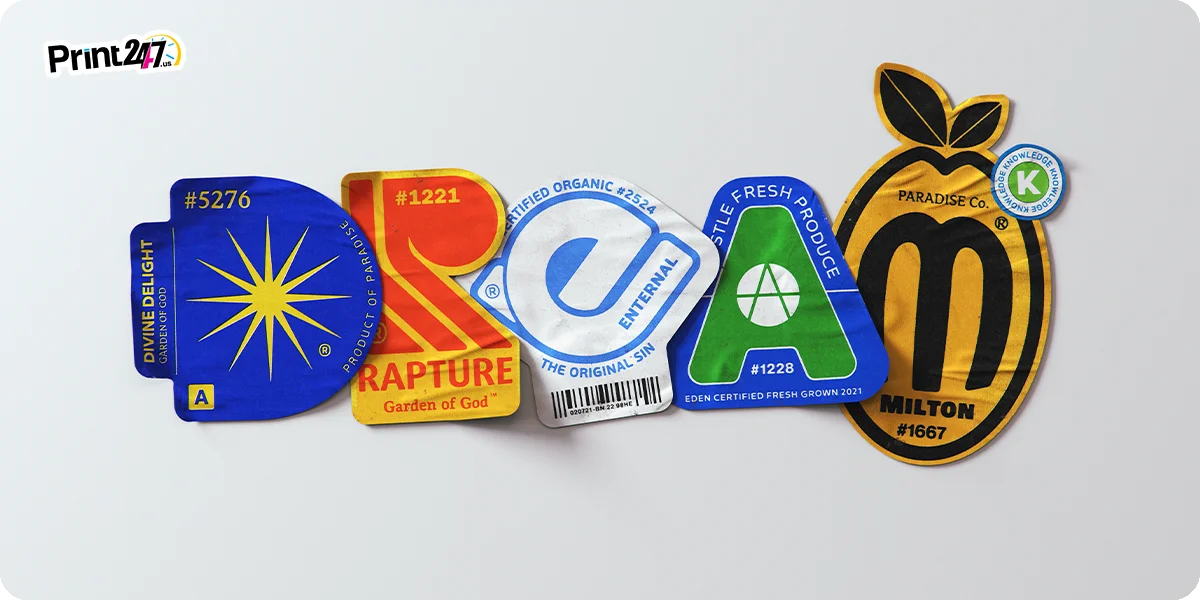
The adhesiveness of stickers is due to pressure-sensitive adhesives (PSAs). This adhesive layer keeps it attached to a surface. Label glue consists of long-chain molecules known as polymers and additives called tackifiers.
Pressing a label onto a product surface causes the glue to run into tiny pores. These molecules form a bond with the surface as the glue cools or dries. There are some adhesives that are designed to be removable, remaining tacky but easily peeled. In some cases, the bond is permanent and forms over time.
The environment affects the strength of adhesives. When glue is heated, it becomes softer and more likely to penetrate surface pores, then hardens and sets. Cold can cause adhesives to crack or break away because they become brittle.
It is also important to keep in mind that adhesive formulas differ by manufacturer and by product use. For example, labels meant for outdoor use on trucks or shipping pallets are built to resist heat, water, and sun. The residue left behind by them is typically greater when they are removed. As a result, brands need to choose labels and inspect adhesives before a run carefully.
Common Causes of Stubborn Adhesive
Sticker residue isn’t always a simple and easy-to-clean mess. This stubborn buildup usually happens for predictable reasons.
- Age is one of the biggest causes. When stickers are left on a surface for a long time, they tend to harden and cure.
- Temperature is another factor. Sunlight and heat can change the chemistry of glue, increasing its stickiness.
- A third cause is the surface itself. A bond is stronger between surfaces that are rough or porous, such as plastic or painted wood.
- There is a fourth cause, which is the type of adhesive used. The purpose of permanent adhesives is simply to prevent them from being removed.
- Finally, the removal technique matters. The label can be torn if you peel the sticker too quickly or at a bad angle, leaving glue behind.
Picking the valuable method for mess removal depends on understanding the root cause. Depending on your issue, you may need stronger solvents for old labels on storage bins. In the case of temporary price tags on new products, heat and a gentle oil may be sufficient.
Why Sticker Residue Removal Matters?
Sticker residue removal matters in many ways. Leaving it on the surface leads to long-term damage, safety hazards, and reduced usability.
Businesses need to consider the appearance of their products when dealing with buyers. There is a look of low quality control when a product or package contains a sticky patch. It is noticed by retail shelf teams as well as customers.
Using sticky residue can prevent logos and prints from being read. As a result, it may also have an adverse effect on the adhesion of new labels. For example, if you place a new barcode over old glue, the barcode might fall off during shipping. That causes scanning errors and delays at packing or at fulfillment centers.
Essential Tools And Materials For Sticker Residue Removal
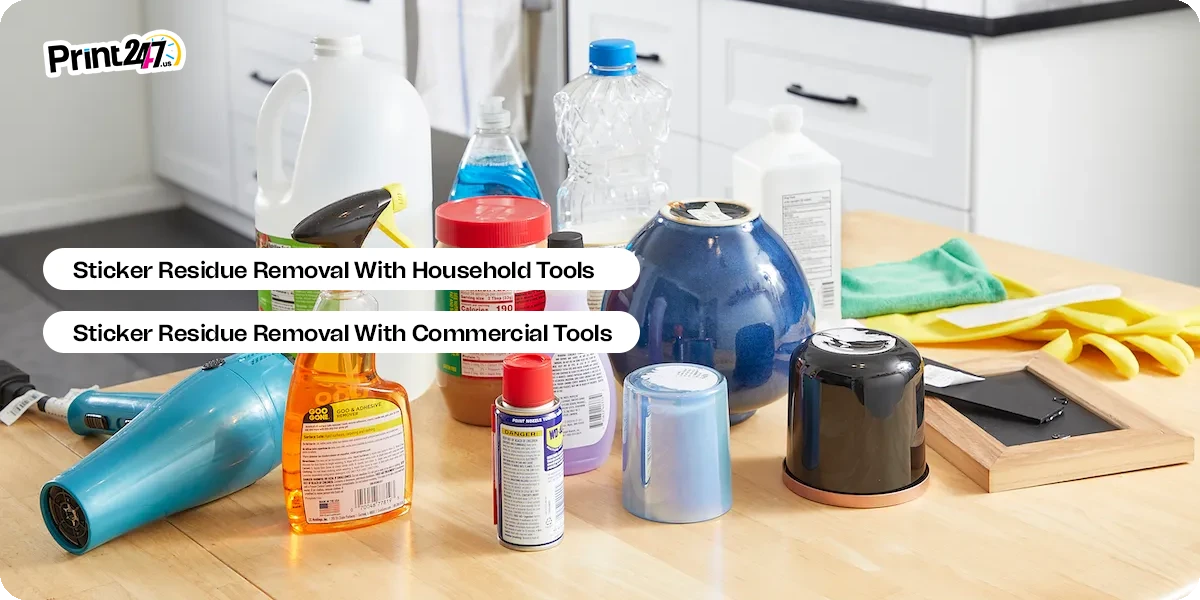
Cleaning kits offer several advantages. In addition to being simple, it is also inexpensive. It should include a few household items as well as one or two commercial products to handle tougher jobs. To react quickly, keep a kit at packing stations, return stations, and warehouse maintenance.
Sticker Residue Removal With Household Tools
Start with household supplies that work well:
- Isopropyl rubbing alcohol
- White vinegar
- Plain vegetable oil or baby oil
- Warm soapy water and dish soap
- Baking soda
- A hair dryer
- Microfiber cloths
- Cotton swabs
- A plastic scraper or old credit card
These items handle most everyday residue from price tags and protective stickers.
Sticker Residue Removal With Commercial Tools
It is essential to use commercial adhesives for older and tougher glues to ensure that the adhesion process is smooth and fast.
- Commercial label remover
- Best sticker residue remover (or best adhesive remover)
- Automotive adhesive remover (safe for paint)
- High-purity isopropyl alcohol (for electronics)
- For large operations, buy industrial wipes made for adhesive removal and set up clear SOPs for use.
How To Remove Sticker Residue From Plastic?
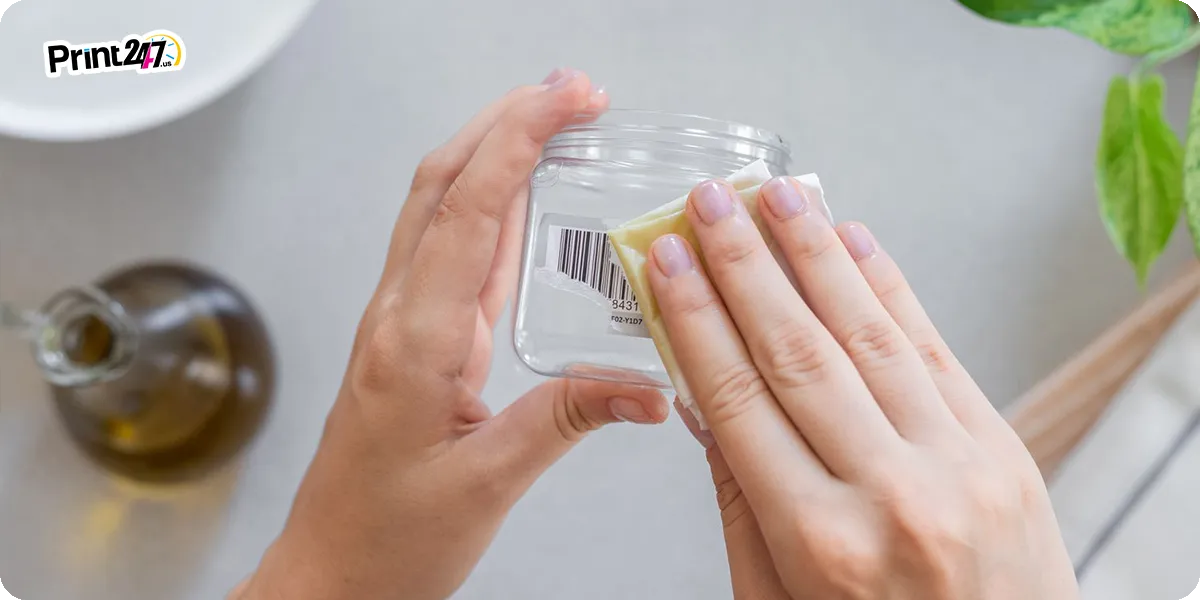
The material plastic is commonly used in packaging, electronics, displays, and product parts. Plastic is most likely to be damaged by solvents when it is being cleaned. The use of acetone or strong solvents will cause some plastics to cloud or discolor, so take gentle steps first.
You must first remove the main layer of paper or film from plastic before you can remove the sticker residue. Use your fingernail or tweezers to lift edges after warming with a hair dryer. In most cases, heat softens the glue and makes it easier to remove the label. You can clean up residue left behind by applying vegetable oil, baby oil, or mineral oil. Give the oil a few minutes to sit for a few minutes. The oil penetrates the glue and loosens it. Use a soft sponge or microfiber cloth to rub gently. Depending on the amount of residue left, a mild abrasive may be required. In most cases, a paste of baking soda and oil will remove residue without scratching.
When the glue has lifted, wash the area with warm, soapy water in order to remove the oil. Once you have removed all oily films, wipe them with rubbing alcohol and let them dry quickly. Use plastic-safe commercial label removers according to the manufacturer's instructions to remove very stubborn glue from hard plastics. Always test first. Prepare a station where staff can warm, treat, and rinse plastic pieces in sequence when cleaning lots of them. It reduces handling time and ensures consistency in output.
How To Remove Sticker Residue From Glass?
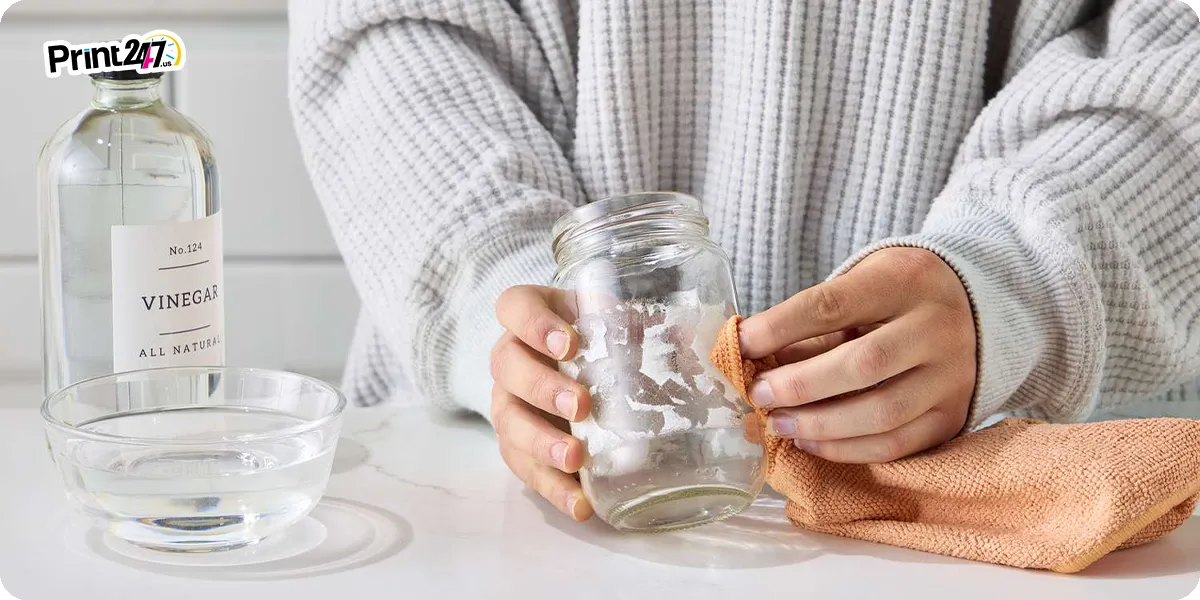
Glass is among the most common victims of sticker residue. These surfaces are easier to clean, but coated, tinted, or printed glass needs care. For regular glass, use nonabrasive methods to avoid streaks.
Follow this step-by-step process to remove sticker or label residue from the glass surface.
- First lift paper bits after softening any large pieces with warm, soapy water.
- Next, apply rubbing alcohol to a microfiber cloth and rub the sticky area.
Alcohol dissolves many adhesives and evaporates quickly, so it is ideal for glass. In case you don’t have alcohol, you can use white vinegar effectively.
Let the vinegar sit on the residue for some time, then rub with a cloth. If the glue on plain glass is very tough, apply some acetone with a cloth to dissolve it quickly. You should avoid using acetone on coated, tinted, or printed glass because it may remove the coating.
To avoid deep scratches when scraping thick residue, use a razor blade on a wet surface held at a low angle. Always wet the glass and keep the blade clean. At last, use a glass cleaner or a vinegar-water mix to clean the glass after removing the glue.
How To Remove Sticker Residue From Metal?
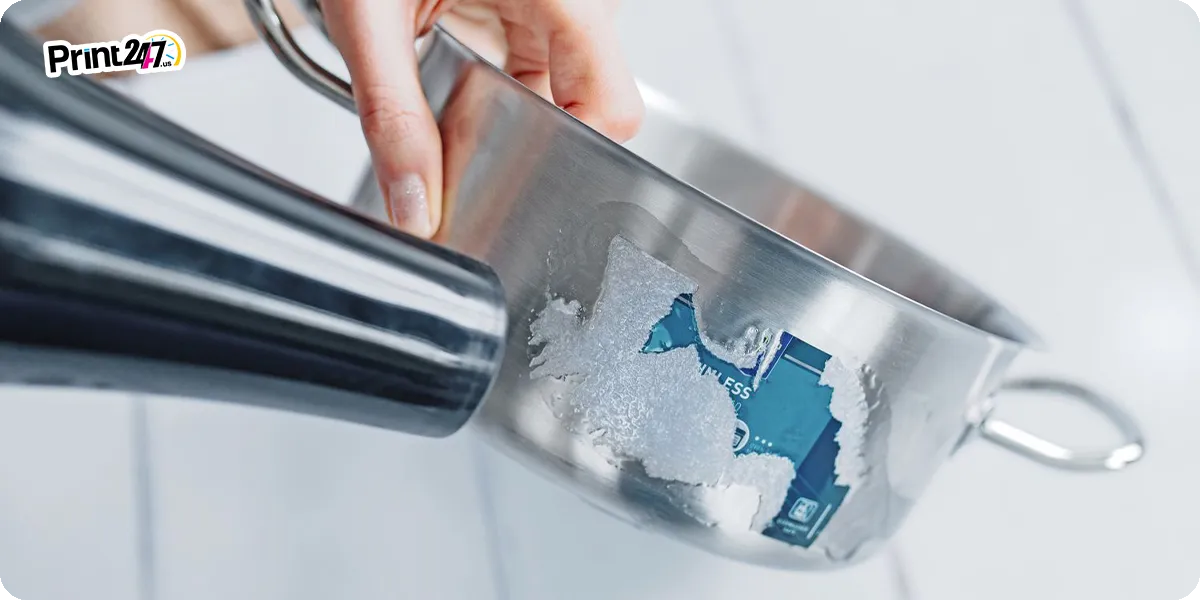
Metal surfaces in custom packaging and manufacturing include stainless steel, aluminum, chrome, and painted metal. Metals generally tolerate stronger solvents than plastic, but painted or plated metal can be damaged by harsh chemicals.
The following steps will help you remove sticker residue from metal.
When removing sticky residue from bare metal, warm the glue with a hair dryer and then apply an oil-based solvent. In the case of vegetable oil or an oil-based sticker solvent, the glue will soak into the oil and its bond will be broken. Once the product has been absorbed for a few minutes, wipe it with a microfiber cloth. For heavier jobs, use a commercial adhesive remover that is best rated for metal.
Avoid metal scrapers that can scratch polished finishes. Use a soft plastic scraper or wooden stick for pressure. Stainless steel used in food equipment should be thoroughly cleaned with soapy water to remove solvent residues, then sanitized as required. When removing a decorative finish from metal, test the remover first and choose a less aggressive product. Afterwards, dry the metal and, if necessary, apply a light polish or protective wax to restore the shine.
How To Remove Sticker Residue From Clothes And Fabrics?
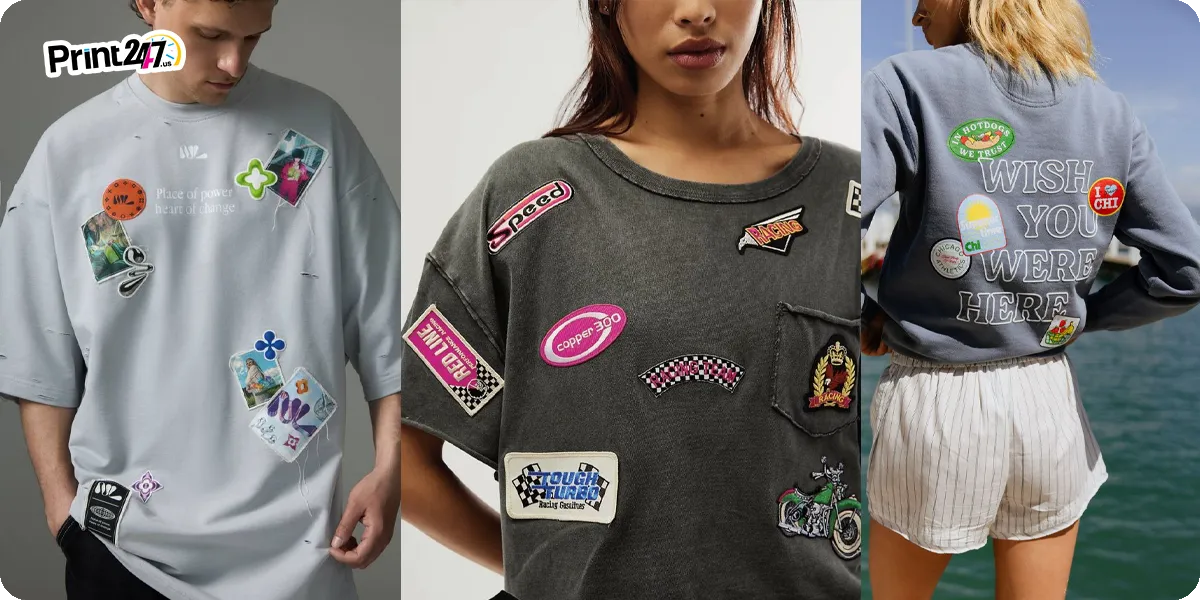
Clothes and soft goods require patience. Fabric fibers are easy to damage, and harsh solvents can remove dye or finish. Begin with the least risky methods.
First, try to chip away large paper pieces with a dull knife. If the glue is still soft, freeze the garment in a sealed plastic bag for an hour. By letting the glue harden, you have a better chance of chipping it off cleanly. It works well for most fabrics if you rub alcohol on a white cloth. The glue will be pushed into the cloth by dabbing alcohol on top of the cloth. When cleaning delicate fabrics, white vinegar or lemon juice is a better choice. Rinse after applying briefly.
If you use oil-based methods, treat the affected surface with dish soap before washing to remove the oil. Launder per the care label after pretreatment. For uniforms or bulk apparel runs, run tests on a sample garment to confirm wash performance and colorfastness. If you have many items with adhesive residue issues, document a standard pretreatment and wash cycle for the laundry or vendor to follow so results are consistent.
How To Remove Sticker Residue From Cars?
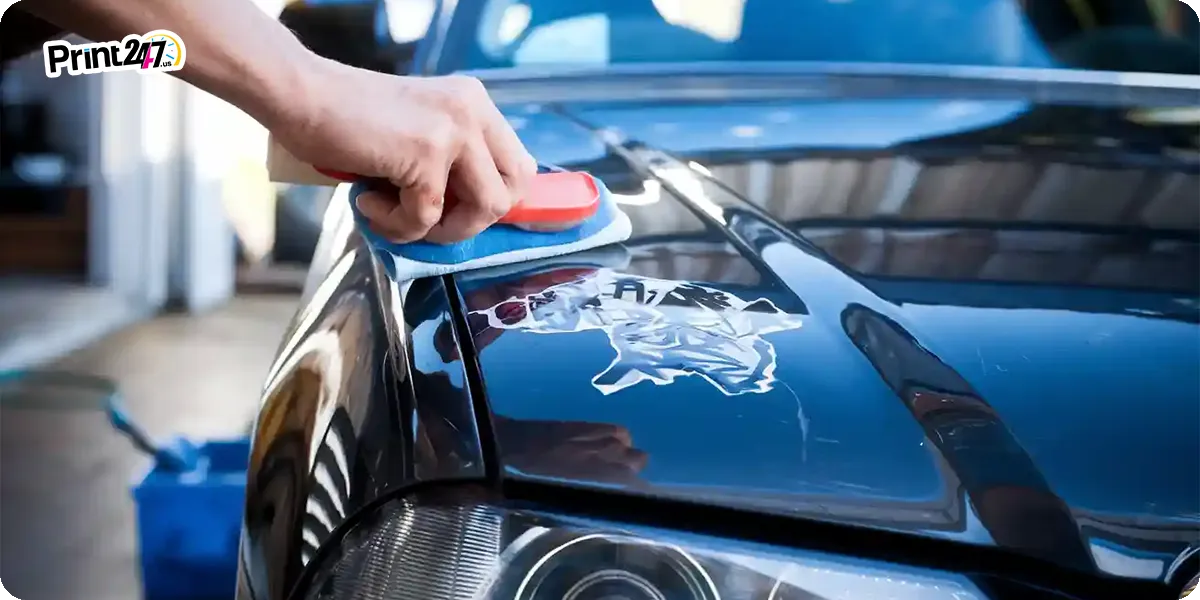
There can be sticker residue on cars because the adhesive can break down or become crumbly over time. Vehicle paint and trim are sensitive to certain solvents. Automotive paint has a clear coat that strong chemicals can damage. Always use automotive-approved products and protect the paint.
The following steps will guide you in removing any type of sticker debris from cars.
- Start by washing the area to remove dirt and grit. Dirt causes scratches when you rub.
- Heat the adhesive with a hair dryer so it becomes softer.
- Then apply an automotive adhesive remover or a product like WD-40 to the spot and let it sit for a few minutes.
- Gently wipe off the glue with a microfiber towel till it lifts. For tougher residue, repeat and do not scrub hard.
- After removal, do a full soap-and-water wash and then apply a polish or wax to restore the paint protection.
The trim pieces can be made of plastic, rubber, or chrome. Make sure you use the product recommended for that material. You should keep an automotive adhesive remover in your garage along with clear instructions for fleet maintenance.
How To Remove Sticker Residue From Laptop & Electronics?
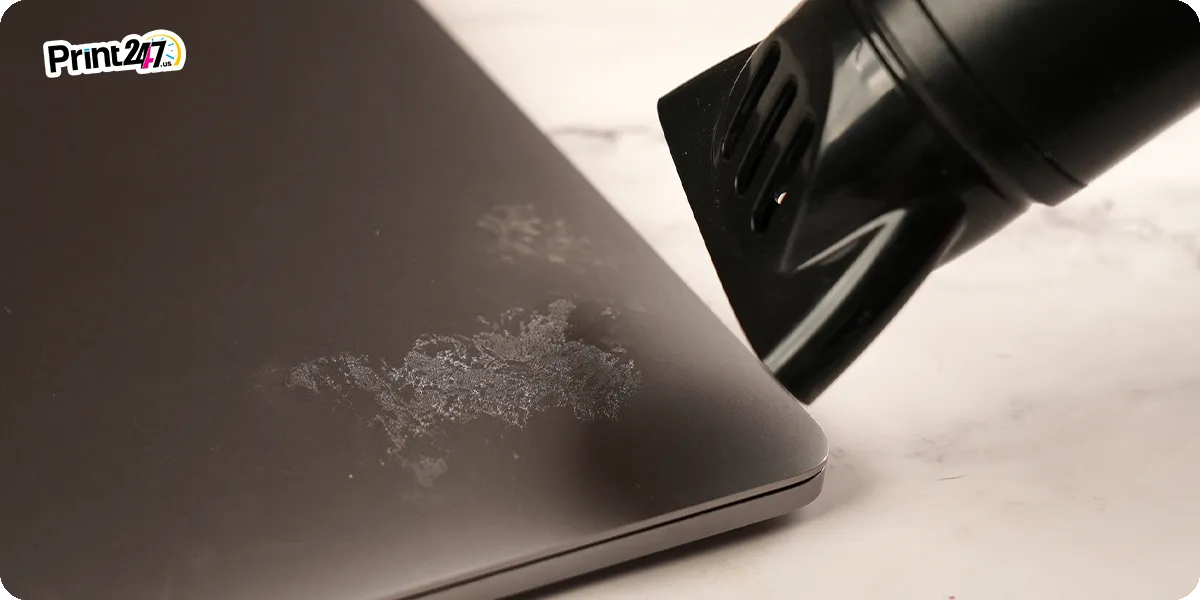
Electronics, including laptops, are sensitive to liquids and heat. During cleaning, dust and sticky residue can accumulate around vents and ports; however, this needs to be done carefully. Adhesive residue degrades the laptop or other electronics items' finishing with the passage of time and leaves hard-to-remove sticky film. This becomes essential to remove to prevent irritation.
Follow this process for removing sticker residue from electronics & laptops.
Turn off the electronic device and unplug any cables. Remove the battery or store the device in a manner that restricts access to the ports.
For residue on plastic or metal housings, warm with a hair dryer to soften the glue and use a barely damp microfiber cloth with rubbing alcohol. Alcohol dries quickly and is safe for many plastics and metals when used sparingly.
Make sure you don't use acetone on plastics or coatings on electrons because it can melt or remove them. With an alcohol-dampened cotton swab, you can clean small crevices and edges. To clean laptop screens after removing adhesive, use a soft cloth and screen-safe cleaners. Don't direct liquids onto keyboards or vents; keep liquids away from them.
If the sticker residue was near laptop ports, use a soft brush to remove any remaining particles and let the device dry fully before powering up. Business IT teams should keep cleaning supplies in a maintenance kit, along with high-purity isopropyl alcohol and damp cloths. Train staff on what quantity to use.
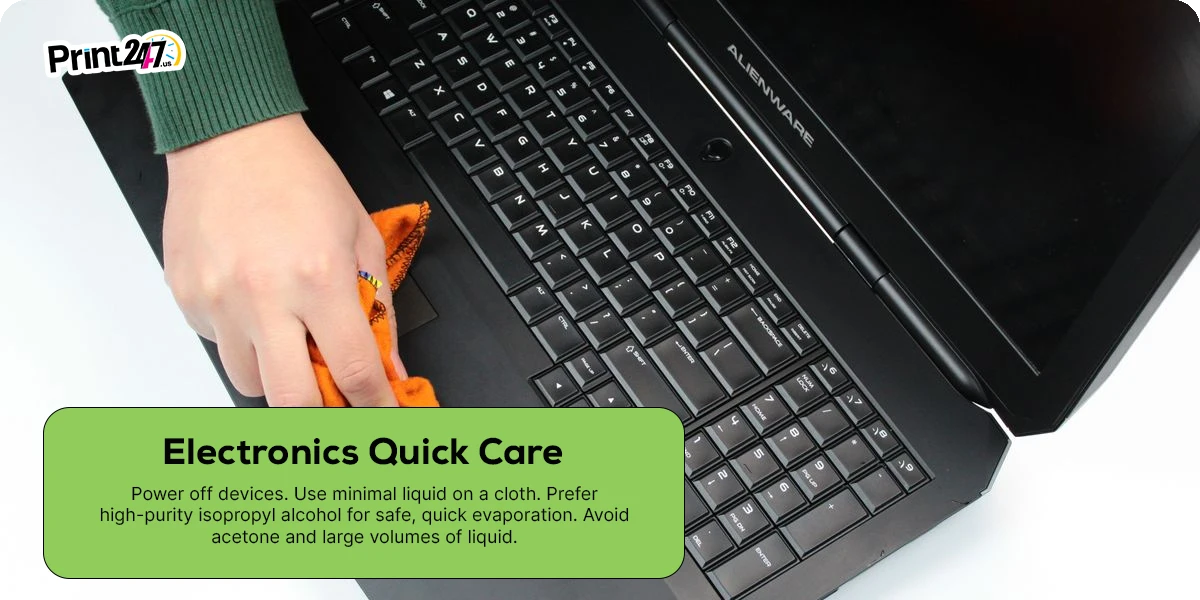
Final Thoughts
A sticker residue could have a negative impact on your brand's reputation and sales. The presence of clean surfaces signals care, whereas the presence of sticky marks implies doubt. B2B operations benefit from a strategic approach that saves time and money.
To remove stickers, begin with gentle methods: heat, oil, and rubbing alcohol. When needed, use a commercial label remover and a trusted best sticker residue remover and make sure to test them first. You should use fabric-safe treatments on fabrics and follow the care labels. Protect vehicles and electronics with products designed for those surfaces.
If your business needs box packaging, Mylar packaging, or labeling help, Print247 is a Texas-based printing and packaging supplier that supports brands with free design help, eco-friendly materials, fast shipping, and physical samples. Sample testing reduces production time and residue problems before a full run. Contact our packaging pro team for a free quote now.
FAQs
How to remove sticker residue from skin safely?
The first thing you should do is wash your hands with warm soapy water and rub them gently. To remove residue, apply a small amount of vegetable oil or baby oil to a cotton pad and gently rub it away until it disappears. Put a moisturizer on your skin after rinsing with soap and water. Skin should not be exposed to acetone.
What is the best way to remove price tag residue?
Use a hair dryer to warm the area, apply rubbing alcohol or oil, and rub with a soft cloth. For fabrics, pretreat and launder. The best way to remove labels from glass and metal is with alcohol or a commercial label remover.
Does vinegar remove label glue from clothes?
White vinegar can help loosen glue on some fabrics. Apply, let sit briefly, then blot and launder. It is milder than solvents, so it works on delicate items but is not guaranteed for all adhesives. Always test first.
How to clean a surface without scratches after removal?
Use plastic scrapers, microfiber cloths, and mild cleaners. Start with oil and alcohol, avoid metal blades on finished surfaces, and work slowly. For very delicate finishes, consult the manufacturer or test on a hidden spot.
Is rubbing alcohol safe for all surfaces?
It is safe to use rubbing alcohol on most glass, metal, and plastic surfaces. Start by testing painted or coated areas. When using electronics, use only a minimal amount of solvent, and ensure that it has evaporated fully before powering up.
What if sticker residue persists on glass?
First, use isopropyl alcohol, then acetone carefully on plain glass. You may need to use a razor blade at a low angle on wet glass only if necessary. If the adhesive residue is very old, it is effective to use commercial adhesive removers. Use a glass cleaner to finish.
Can I use WD-40 as a sticky glue removal?
It is true that WD-40 removes many adhesives from hard surfaces. After the oily residue has been removed, clean the area with soap and water. It is not recommended to use WD-40 on fabrics or paints without first testing them.































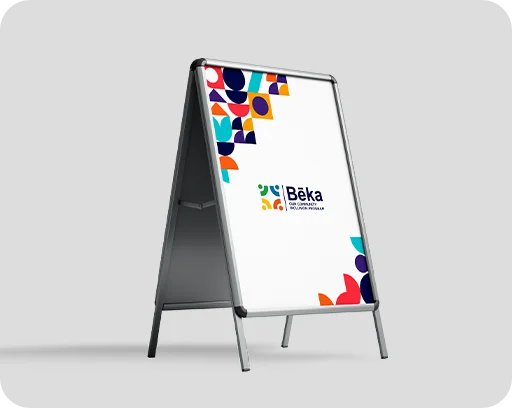


















.jpg)
.jpg)
.jpg)